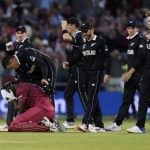Who knows which England will turn up at the Cricket World Cup
England have entertained and disappointed in equal measure at the World Cup, despite their batting firepower. And not even they know which side will turn up for the semifinal against Australia.
Author:
11 July 2019

Mercurial and unpredictable, you just never know which version of this side will show up on the day. These are patronising descriptions usually reserved for Pakistan and the West Indies. They are stereotypes that acknowledge the latent genius lurking in these two economically disadvantaged teams but suggest an erraticism and lack of discipline that results in perennial underperformance.
Based on the evidence of the past six weeks at the ICC Cricket World Cup, another side could, and should, be spoken of in such terms. With a greater propensity than most for oscillations between the sublime and the abject, England is arguably the most two-faced of all cricketing nations.
Eoin Morgan’s team waltzed into a home World Cup ranked as the No. 1 side in the world. A four-year project following the ignominy of the 2015 showpiece had transformed the Three Lions from kittens into apex predators. Their batters wielded bats laced with nitroglycerin and learned to treat the loss of a wicket like a drunk driver treats a pothole, ignoring it entirely as the accelerator remained firmly pressed.
Related article:
In the immediate aftermath of the 2015 World Cup, England scored 408, 365, 302 and 350 against New Zealand. They then won a tense reduced-overs match in the fifth game to claim the series. From then, Morgan and new coach Trevor Bayliss instilled a cavalier psychology within the side. “You score 350, we’ll score 400” became the mantra. They often did.
In 2016, Alex Hales blitzed Pakistan to all corners of Trent Bridge in Nottingham to register 171 off just 122 balls in helping his side amass 444/3. Two years later, on the same ground, he scored 147 off an eye-watering 92 balls as England set a world record 481/6 against Australia.
However, an underlining concern remained. On flat tracks in small venues, the side looked unstoppable. But like that same drunk driver who floors it over minor divots, occasionally the wheels came off and catastrophe struck.
Adjusting to power hitting
In 2017, South Africa’s Kagiso Rabada reduced England to 20/6 at Lord’s as batter after batter came out swinging, seemingly oblivious to what had transpired before his arrival at the wicket. Then, a month later, in Cardiff, an inability to read the conditions saw England bowled out for 211 by Pakistan in the Champions Trophy semifinal in which they were resoundingly beaten by eight wickets.
“We left ourselves short adapting to conditions,” Morgan said afterwards. Roman legionaries were notoriously poor at reconnaissance, believing that their imperial might and iron-drilled formations would be enough to compensate for a lack of scouting. The English skipper conceded that his troops had allowed hubris to cloud their judgement.
Following that unexpected loss, the drawing board was revisited and a new plan devised. Well, not exactly a new plan, just a variation on the old one. Collapses were deemed acceptable, inevitable even, given the way the side could bat.
This mindset was vindicated with commanding displays in a series of contests with the West Indies (4-0), Australia (4-1), New Zealand (3-2), Australia (5-0), India (2-1), Sri Lanka (4-1), the West Indies (2-2) and Pakistan (4-0) where they only failed to win one, proving that they had stumbled on a foolproof formula for sustained success. Four years of planning, countless hours of analysis, millions of pounds spent, an overhaul of the central contract structure, an almost fanatical devotion to “positive” cricket… it would all be worth it if that elusive World Cup triumph was achieved.
Speed humps on the road to glory
There were troubles, of course. Hales was dropped from the World Cup squad after he tested positive for recreational drug use for the second time in his career, thereby falling foul of the England and Wales Cricket Board’s (ECB) code of conduct.
Then there was the matter of Jofra Archer, the Barbados-born tearaway with the ability to crank it at more than 150km/h while looking impeccably relaxed. He was the missing ingredient in an English attack that had spin and control and swing and middle over nous, but not raw, unbridled pace. It seemed like a no-brainer to include him.
The only problem was he wasn’t eligible for selection under existing qualification rules. No bother then. Knowing that a World Cup was at stake, the ECB relaxed its own laws to shoehorn Archer into the squad at the expense of someone else who had helped build Project 2019.
Related article:
“Would I want to see someone like Liam Plunkett left out? No,” said fellow fast bowler Mark Wood before the provisional squad was announced in April, speaking into a narrative that had started to develop concerning team cohesion and the fairness of sport at the elite level. Neither Wood nor Plunkett were axed, with David Willey the unfortunate man to miss out as his comparatively pedestrian left-armed swingers were deemed inferior to the thunderbolts delivered by Archer.
In the opening game of this World Cup, that decision paid dividends when Archer burst through Hashim Amla’s pull shot and hammered the Proteas opener flush on the helmet. It was a blow that sent a shockwave reverberating around the campaign and supplemented a breathtaking overhead catch from Ben Stokes in a comprehensive 104-run win.
England looked the real deal. Cricket was coming home. The team comprised individuals born in the Caribbean, Cape Town, Christchurch and Dublin. Of the 15 players in the squad, eight were state educated with seven graduating from private schools. Counties all across the soggy isles are represented. Three players are from black or ethnic minority backgrounds, accurately reflecting the demographics of the United Kingdom as a whole.
This was sold as the people’s team in a historically exclusionary sport. A team that could serve as a lightning rod for a country fractured by Brexit and populism and hate speech and austerity. At least that was the party line. In truth, only a handful of Brits have actually seen the side play with matches locked away behind expensive tickets and terrestrial television. Compared to the Fifa Women’s World Cup and Wimbledon, the Cricket World Cup has largely remained a fringe event for locals, drowned out by frothing Asian fans.
Inconsistent display
In England’s second game, their hapless bowlers, Archer included, allowed Pakistan’s batters to cruise to 348/8, which proved 14 runs too many in the chase. They brushed themselves off and cantered to comfortable victories over Bangladesh, the West Indies and then Afghanistan, with Morgan hitting 17 sixes in a score of 148 off 71 balls. Then, in the absence of power hitting opener Jason Roy, they fell to Sri Lanka and Australia by 20 and 64 runs respectively, which left them facing a humiliating group stage exit.
Sublime to abject followed by sublime and more abject, a pattern was emerging. After the Australian defeat, Morgan fielded difficult questions from an unforgiving press. The England skipper was visibly impacted and spat back monosyllabic answers, refusing to entertain the possibility that the past four years might have been a waste.
Next came Virat Kohli’s Indians, a daunting task without the pressure of staying alive in a competition that was meant to be a victory parade. With the proverbial Sword of Damocles hanging over them, England produced their most polished performance of the competition. Roy and fellow opener Jonny Bairstow got off to a flyer, reaching 160 in 22 overs. Roy registered 66, Bairstow was imperious for his 111. Stokes biffed 79 off 54 to drag the score to 337/7, which remained just out of India’s reach despite another ton from Rohit Sharma.
In the final group game against New Zealand, Bairstow reeled off a consecutive hundred and Wood wrapped up the Kiwi tail in a 119-run win that secured England a spot in the semifinals for the first time since 1992.
Related article:
What to make of this side? On their day, they have a serious claim to being the best one-day international side in history. That may sound hyperbolic, but you’d be hard-pressed to find a top six that has possessed more firepower than Roy, Bairstow, Joe Root, Jos Buttler, Morgan and Stokes. If you’re still not convinced, then consider that Adil Rashid often bats at 11 with a career average of just under 20 and a strike rate of 102.
Morgan and Bayliss have come too far to deviate from the plan. They are two games away from realising a dream four years in the making. If the stars align, if the universe delivers, if Morgan can win two consecutive tosses, then only a fool would bet against England lifting the trophy at Lord’s.
But there is every chance that things could go horribly wrong. What if instead of a sublime performance against Australia in Birmingham on Thursday 11 July, they produce another abject display and don’t reach the final where New Zealand awaits their opponents? What if instead of a deluge of sixes and fours, their batters write another chapter in the tale of great English collapses? That is the risk with mercurial sides. You just never know which England will turn up.



